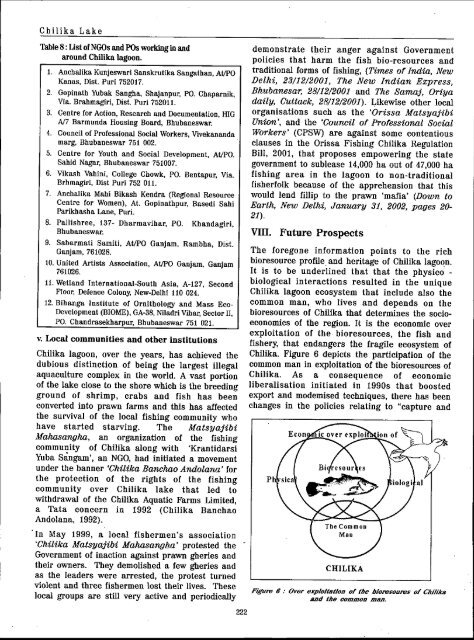06-bioresourcesstatu.. - M. S. Swaminathan Research Foundation
06-bioresourcesstatu.. - M. S. Swaminathan Research Foundation
06-bioresourcesstatu.. - M. S. Swaminathan Research Foundation
You also want an ePaper? Increase the reach of your titles
YUMPU automatically turns print PDFs into web optimized ePapers that Google loves.
Chilika Lake<br />
Table8:ListofNGOsand POsworkinginand<br />
around Chilika lagoon.<br />
t. Anchalika Kunjeswari Sanskrutika Sangathan, AtlPO<br />
Kanas, Dist. Puri 752017.<br />
2. Gopinath Yubak Sangha, Shajanpur, PO. Chaparnik,<br />
Via. Brahmagiri, Dist. Puri 75201 t.<br />
3. Centre for Action, <strong>Research</strong> and Documentation, RIG<br />
N7 Barmunda Housing Board, Bhubaneswar.<br />
4. Council of Professional Social Workers, Vivekaoanda<br />
marg, Bhubaneswar 75t 002. .<br />
5. Centre lor Youth and Social Development, AtlPO.<br />
Sahid Nagar, Bhubaneswar 751007.<br />
6. Vikash Vahini, College Chowk, PO. Bentapur, Via.<br />
Brhmagiri, Dist Puri 752 01t.<br />
7. Anchalika Mahi Bikash Kendra (Regional Resource<br />
Centre lor Women), At. Gopinathpur, Basedi Sahi<br />
Parikhasha Lane, Purl.<br />
8. Pallishree, 137- Dharmavihar, PO. Kbandagiri,<br />
Bhubaneswar.<br />
9. Sabarmati Samiti, AtlPO Ganjam, Rambha, Dist.<br />
Ganjam, 761028.<br />
10. United Artists Association, AtlPO Ganjam, Ganjam<br />
761026.<br />
It. Wetland International-South Asia, A-127, Second<br />
Floor, Defence Colony, New-Delhi 110 024.<br />
12. Bihanga Institute of Ornithology and Mass Eco-<br />
Development (BlOME), GA-38, Niladri Vlhar, Sector II,<br />
PO. Chandrasekharpur, Bhubaneswar 751 02t.<br />
v. Local communities and other institutions<br />
Chilika lagoon, over the years, has achieved the<br />
dubious distinction of being the largest illegal<br />
aquaculture complex in the world. A vast portion<br />
of the lake close to the shore which is the breeding<br />
ground of shrimp, crabs and fish has been<br />
converted into prawn farms and this has affected<br />
the survival of the local fishing community who<br />
have started starving. The Matsyajibi<br />
Malwsanglla, an organization of the fishing<br />
community of Chilika along with 'Krantidarsi<br />
Yuba Sangam', an NGO, had initiated a movement<br />
under the banner 'Chilika Bancllao Andolana' for<br />
the protection of the rights of the fishing<br />
community over Chilika lake that led to<br />
withdrawal of the Chilika Aquatic Farms Limited,<br />
a Tata concern in 1992 (Chilika Banchao<br />
Andolana, 1992).<br />
. In May 1999, a local fishermen's association<br />
'Chilika Matsyajibi Malwsangha' protested the<br />
Government of inaction against prawn gheries and<br />
their owners. They demolished a few gheries and<br />
as the leaders were arrested, the protest turned<br />
violent and three fishermen lost their lives. These<br />
local groups are still very active and periOdically<br />
222<br />
demonstrate their anger against Government<br />
policies that harm the fish bio-resources and<br />
traditional forms of fishing, (Times of India, New<br />
Delhi, 23/12/2001, The New Indian Express,<br />
Bhubanesar, 28/12/2001 and The Samaj, Oriya<br />
daily, Cuttack, 28/12/2001). Likewise other local<br />
organisations such as the 'Orissa Matsyajibi<br />
Union', and the 'Council of Professional Social<br />
Workers' (CPSW) are against some contentious<br />
clauses in the Orissa Fishing Chilika Regulation<br />
Bill, 2001, that proposes empowering the state<br />
government to sublease 14,000 ha out of 47,000 ha<br />
fishing area in the lagoon to non-traditional<br />
fisherfolk because of the apprehension that this<br />
would lend fillip to the prawn 'mafia' (Down to<br />
Earth, New Delhi, January 31, 2002, pages 20-<br />
21).<br />
VIII. Future Prospects<br />
The foregone information points to the rich<br />
bioresource profile and heritage of Chilika lago~n.<br />
It is to be underlined that that the physico _<br />
biological interactions resulted in the unique<br />
Chilika lagoon ecosystem that include also the<br />
common man, who lives and depends on the<br />
bioresources of Chilika that determines the socioeconomics<br />
of the region. It is the economic over<br />
exploitation of the bioresources, the fish and<br />
fishery, that endangers the fragile ecosystem of<br />
Chilika. Figure 6 depicts the participation of the<br />
common man in exploitation of the bioresources of<br />
Chilika. As a consequence of economic<br />
liberalisation initiated in 1990s that boosted<br />
export and modemised techniques. there has been<br />
changes in the policies relating to "capture and<br />
CHILIKA<br />
Figure 6 : (}yer explollatlon of (be lJloresou.res of Ch1l1ka<br />
and the common man.










